Answered step by step
Verified Expert Solution
Question
1 Approved Answer
Momentum Objective To investigate the Law of Conservation of Momentum by analyzing one-dimensional elastic and inelastic collisions. Introduction Momentum is a vector property of
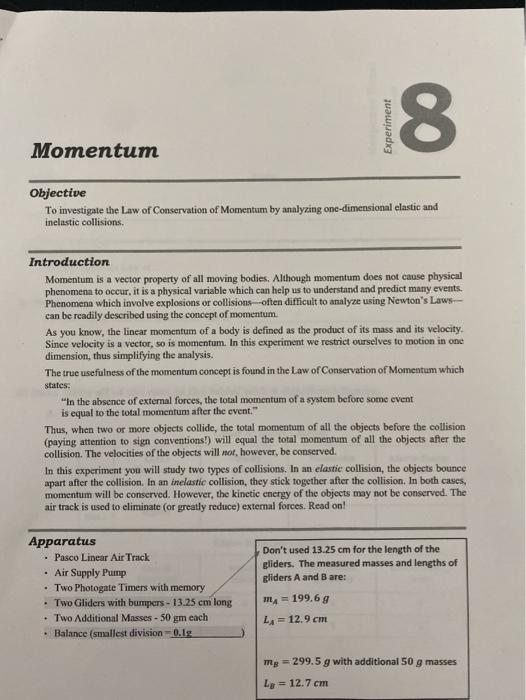
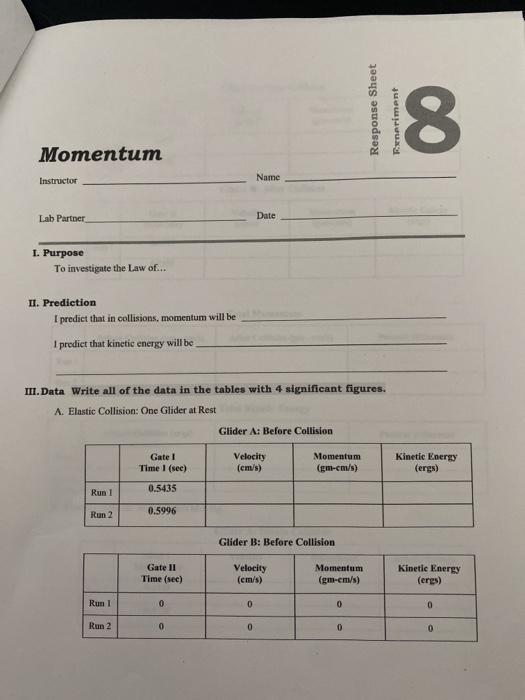
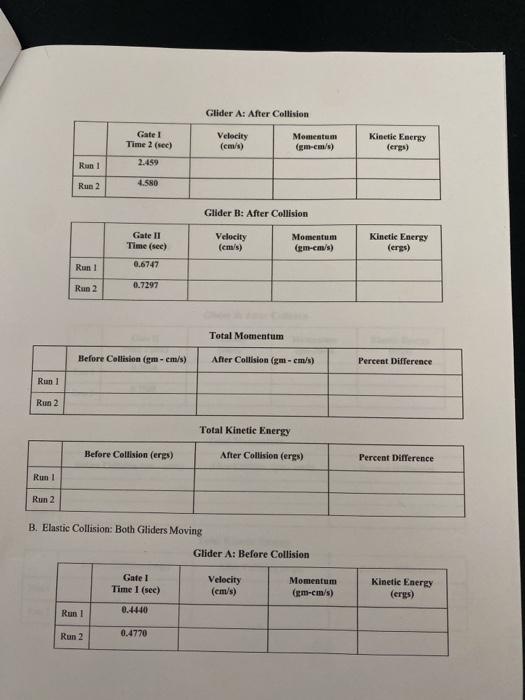
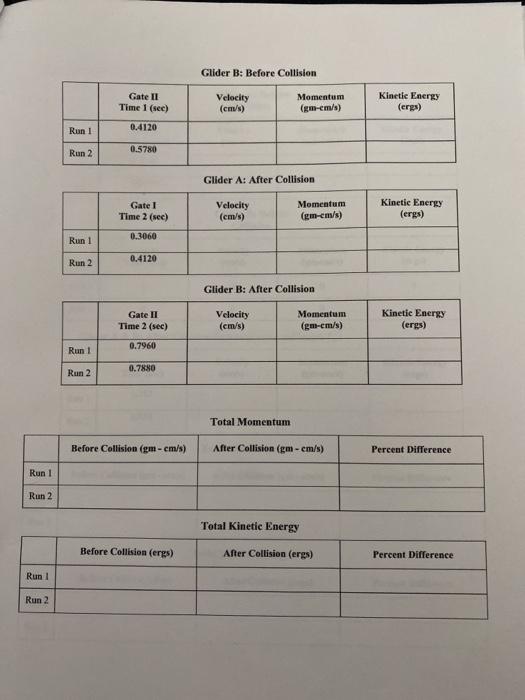
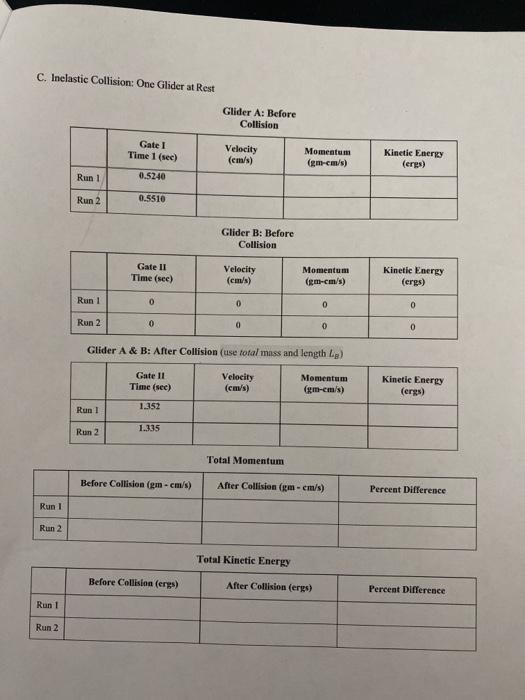
Momentum Objective To investigate the Law of Conservation of Momentum by analyzing one-dimensional elastic and inelastic collisions. Introduction Momentum is a vector property of all moving bodies. Although momentum does not cause physical phenomena to occur, it is a physical variable which can help us to understand and predict many events. Phenomena which involve explosions or collisions-often difficult to analyze using Newton's Laws can be readily described using the concept of momentum. As you know, the linear momentum of a body is defined as the product of its mass and its velocity. Since velocity is a vector, so is momentum. In this experiment we restrict ourselves to motion in one dimension, thus simplifying the analysis. The true usefulness of the momentum concept is found in the Law of Conservation of Momentum which states: 18 Experiment Thus, when two or more objects collide, the total momentum of all the objects before the collision (paying attention to sign conventions!) will equal the total momentum of all the objects after the collision. The velocities of the objects will not, however, be conserved. Apparatus "In the absence of external forces, the total momentum of a system before some event is equal to the total momentum after the event." In this experiment you will study two types of collisions. In an elastic collision, the objects bounce apart after the collision. In an inelastic collision, they stick together after the collision. In both cases, momentum will be conserved. However, the kinetic energy of the objects may not be conserved. The air track is used to eliminate (or greatly reduce) external forces. Read on! . Air Supply Pump Two Photogate Timers with memory Two Gliders with bumpers-13.25 cm long Two Additional Masses- 50 gm each Balance (smallest division 0.1g . Pasco Linear Air Track Don't used 13.25 cm for the length of the gliders. The measured masses and lengths of gliders A and B are: MA 199.6 g L = 12.9 cm mg = 299.5 g with additional 50 g masses La = 12.7 cm Momentum Instructor Lab Partner I. Purpose To investigate the Law of... II. Prediction I predict that in collisions, momentum will be 1 predict that kinetic energy will be Run 1 Run 2 Run 1 III. Data Write all of the data in the tables with 4 significant figures. A. Elastic Collision: One Glider at Rest Run 2 Gate I Time 1 (sec) 0.5435 0.5996 Gate II Time (sec) 0 0 Name Date Glider A: Before Collision Velocity (cm/s) 0 Glider B: Before Collision Velocity (cm/s) 0 Momentum (gm-cm/s) Momentum (gm-cm/s) 0 Response Sheet 0 18 Exneriment Kinetic Energy (ergs) Kinetic Energy (ergs) 0 0 Run 1 Run 2 Run 1 Run 2 Run 1 Run 2 Run 1 Run 2 Gate I Time 2 (sec) 2.459 Run 1 4.580 Run 2 Gate II Time (see) 0.6747 Before Collision (gm-cm/s) 0.7297 Before Collision (ergs) B. Elastic Collision: Both Gliders Moving Gate I Time I (see) 0.4440 0.4770 Glider A: After Collision Velocity (cm/s) Glider B: After Collision Velocity (cm/s) Total Momentum Momentum (gm-cm/s) Momentum (gm-cm/s) Total Kinetic Energy After Collision (gm-cm/s) After Collision (ergs) Glider A: Before Collision Velocity (cm/s) Momentum (gm-cm/s) Kinetic Energy (ergs) Kinetic Energy (ergs) Percent Difference Percent Difference Kinetic Energy (ergs) Run 1 Run 2 Run I Run 2 Run I Run 2 Run 1 Run 2 Run 1 Run 2 Gate II Time 1 (sec) 0.4120 0.5780 Gate I Time 2 (sec) 0.3060 0.4120 Gate II Time 2 (sec) 0.7960 0.7880 Before Collision (gm-cm/s) Before Collision (ergs) Glider B: Before Collision Velocity (cm/s) Glider A: After Collision Velocity (cm/s) Momentum (gm-cm/s) Velocity (cm/s) Glider B: After Collision Total Momentum Momentum (gm-cm/s) Momentum (gm-cm/s) After Collision (gm-cm/s) Total Kinetic Energy After Collision (ergs) Kinetic Energy (ergs) Kinetic Energy (ergs) Kinetic Energy (ergs) Percent Difference Percent Difference C. Inelastic Collision: One Glider at Rest Run I Run 2 Run I Run 2 Run 1 Run 2 Run 1 Run 2 Run 1 Gate I Time 1 (sec) 0.5240 0.5510 Run 2 Gate II Time (see) 0 0 Gate II Time (sec) 1.352 1.335 Before Collision (gm-cm/s) Glider A: Before Collision Before Collision (ergs) Velocity (cm/s) Glider B: Before Collision Velocity (cm/s) 0 0 Glider A & B: After Collision (use total mass and length Lg) Velocity (cm/s) Total Momentum Momentum (gm-cm/s) Momentum (gm-cm/s) Total Kinetic Energy 0 0 Momentum (gm-em/s) After Collision (gm-cm/s) After Collision (ergs) Kinetic Energy (ergs) Kinetic Energy (ergs) 0 0 Kinetic Energy (ergs) Percent Difference Percent Difference
Step by Step Solution
There are 3 Steps involved in it
Step: 1
The provided document outlines a lab experiment investigating the Law of Conservation of Momentum in ...
Get Instant Access to Expert-Tailored Solutions
See step-by-step solutions with expert insights and AI powered tools for academic success
Step: 2

Step: 3

Ace Your Homework with AI
Get the answers you need in no time with our AI-driven, step-by-step assistance
Get Started


